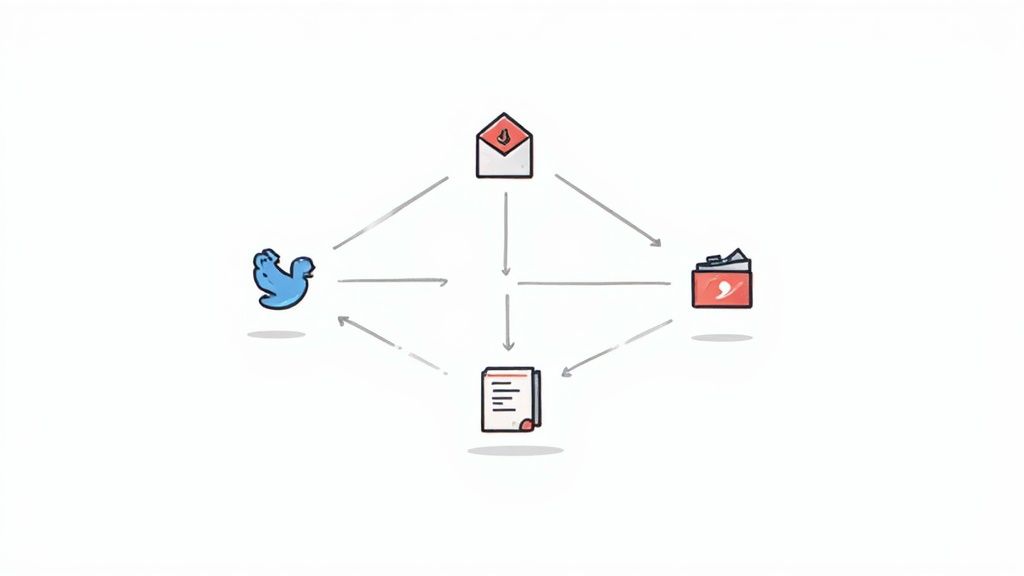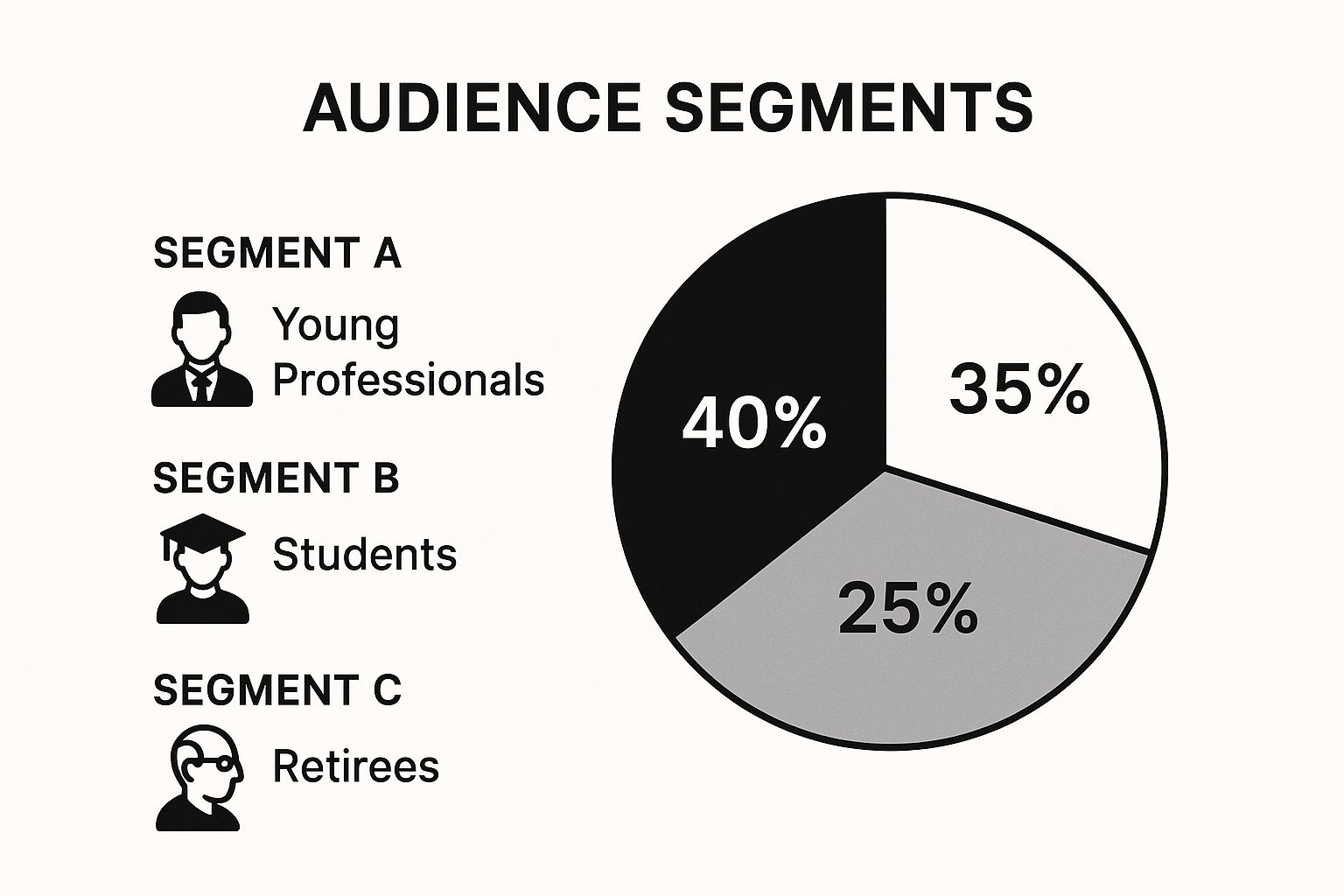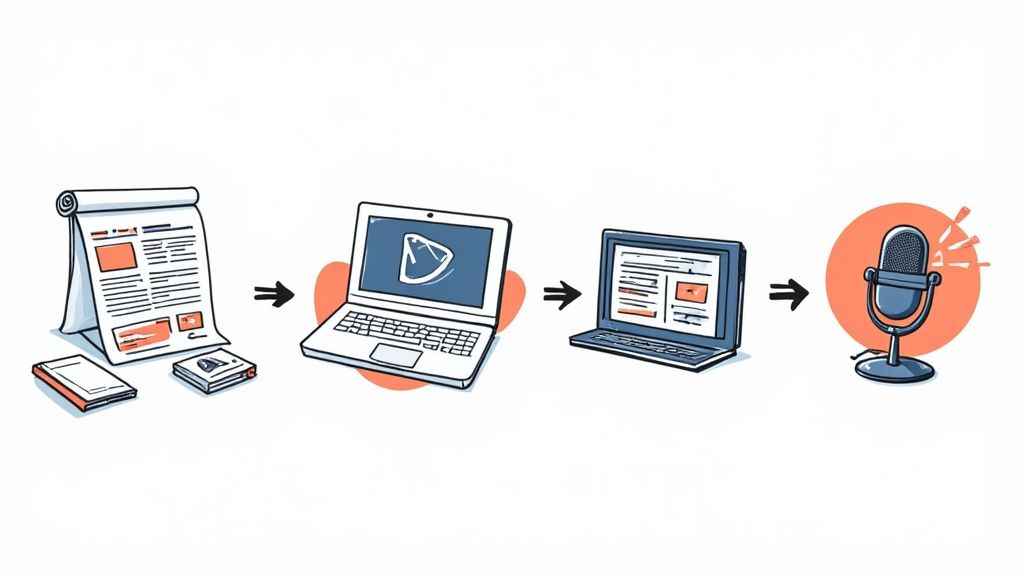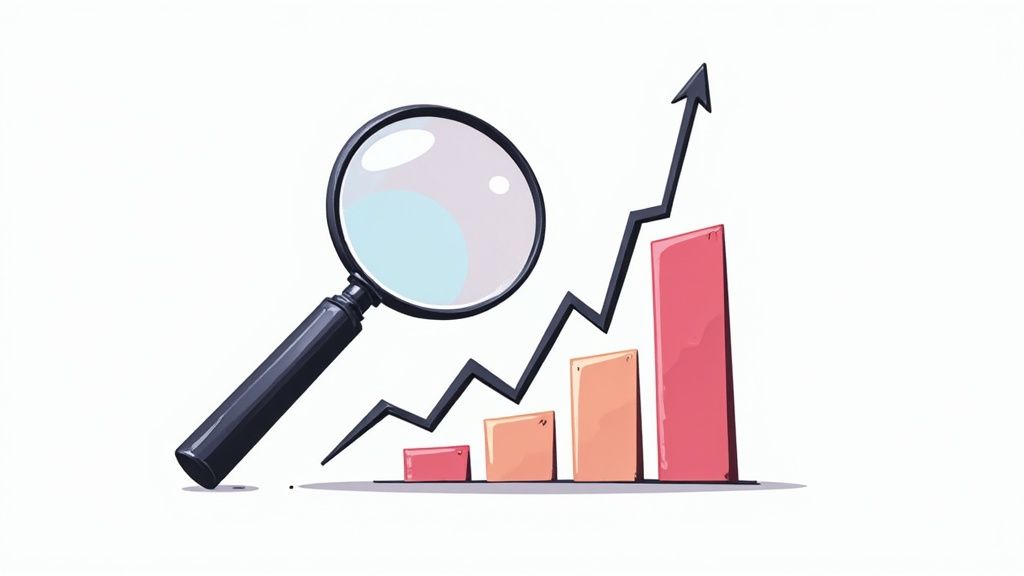Your Content Distribution Strategy Playbook

Creating amazing content is just the first lap of the race. A content distribution strategy is the map you follow to share that content across all the right channels, making sure it actually connects with your target audience and turns all your hard work into real results.
Why You Can't Afford to Skip a Distribution Strategy
Thinking about distribution after the content is finished is one of the most common—and costly—mistakes I see. It’s not just the final step; it's the engine that drives your entire content marketing machine.
Without a solid plan, even the most brilliant article or eye-opening video will just sit on your blog, gathering digital dust. No traffic, no leads, no brand awareness. It's a huge waste of potential.
A well-designed content distribution strategy is what bridges the gap between your creative efforts and tangible business outcomes. It’s how you guarantee your investment in content creation actually pays off.
From Creation to Connection
Your goal isn't just to hit "publish." It's about building a genuine connection with an audience. A strategic approach means you're intentionally showing up where your potential customers are already spending their time.
This could be their favorite social media feed, a niche forum they trust, or right in their email inbox. By meeting them on their turf, you stop being an interruption and start becoming a valued resource. That's how you build trust and position your brand as a go-to authority.
If you're looking for more ways to get your content out there, these 10 powerful content distribution strategies are a great starting point for amplifying your reach.
Fueling Growth and Loyalty
Let's be clear: effective distribution directly fuels business growth. It's the mechanism that drives traffic back to your website, fills your pipeline with qualified leads, and keeps your brand top-of-mind. This isn't just a hunch; the data backs it up.
A strong content distribution strategy is essential for business success. Research shows that 83% of marketers see content marketing as their most effective method for generating demand, and 63% report it has helped them build customer loyalty.
With 45% of marketing leaders planning to increase their content budgets, the focus on distribution as a key growth driver has never been clearer. You can get a closer look at how content performance statistics highlight these trends.
Ultimately, a distribution strategy turns your content from a static asset into a dynamic tool for growth. It’s the difference between sending a message into the void and ensuring it gets received, understood, and acted upon by the right people—transforming readers into loyal customers.
Laying the Groundwork for Distribution Success

Before you even think about sharing a single link or scheduling a post, you need to build a solid foundation. A winning content distribution strategy isn't just random acts of sharing—it's built on a crystal-clear understanding of who you're talking to and what you want to achieve.
Jumping into promotion without this prep work is like setting sail without a map. You might get some traction, but you’ll never reliably reach your destination. Getting this foundational stage right ensures every bit of effort you put into distribution is deliberate and tied directly to your business goals.
Start With Your Audience, Not Your Channels
I see this all the time: marketers pick their channels first. They decide to be on LinkedIn, Instagram, and X before asking the most critical question: where does our ideal audience actually spend their time and look for information?
Forget defaulting to the big, popular platforms. Your first move should always be deep audience research. You need to build a persona that’s more than just basic demographics. What are their daily routines? What professional headaches are they dealing with? Where do they go for advice?
- Social Platforms: Which networks are for their professional growth versus their personal time?
- Communities: Are they hanging out in niche Slack channels, Reddit communities, or old-school industry forums?
- Search Behavior: What exact phrases and questions do they type into Google when they're looking for solutions?
- Trusted Sources: Who are the key influencers, publications, and thought leaders they already follow and trust?
Answering these questions gives you a behavioral road map. It points you to the exact places where your content won't just be seen, but actually welcomed.
Set Goals That Actually Matter
"Getting more eyeballs on our content" is not a business goal. It's a wish. Your distribution goals must be specific, measurable, and connected to a real business outcome. Vague goals lead to vague results, and you'll never be able to prove your value.
So, get concrete about what success looks like. Here are a few examples of goals that have teeth:
- Increase Qualified Leads: Generate 50 new MQLs from our latest ebook within the next quarter.
- Boost Referral Traffic: Drive a 30% increase in referral traffic from our guest posting and media placement efforts over the next six months.
- Enhance Engagement: Improve the average engagement rate on our LinkedIn posts by 25% to build a more active community.
By setting concrete goals, you turn distribution from a simple "sharing" task into a strategic growth engine. It creates accountability and gives you clear benchmarks to measure against.
Audit Your Existing Content and Channels
Chances are, you're sitting on a goldmine of content you can use right now. A quick content and channel audit will show you what's already working, what’s falling flat, and where your hidden opportunities are.
Start by looking at your content from the last 12-18 months. Dive into your website analytics, social media data, and email marketing reports to find your greatest hits. Why did these specific pieces do so well? Was it the topic? The format? The channels you used?
Next, put your current distribution channels under the microscope.
| Channel Review | Key Question | Actionable Insight |
|---|---|---|
| Website Blog | Is our SEO consistently bringing in organic traffic for our key posts? | Find the high-traffic posts you can update and redistribute. |
| Email List | What's our click-through rate on content-focused emails? | Segment your list to send more relevant, targeted content. |
| Social Media | Which platform drives the most qualified referral traffic, not just likes? | Double down on the platforms that deliver real results and test new formats there. |
This audit provides a data-backed starting point. Now you can confidently decide which content to repurpose, which channels to focus on, and where you can afford to experiment.
With your audience defined, your goals set, and your assets audited, you finally have a strategic roadmap. Now you're ready to pick the right channels and bring your content distribution strategy to life.
Choosing Your Owned, Earned, and Paid Channels
A powerful content distribution strategy isn’t about shouting from every digital rooftop. It’s about having meaningful conversations in the right places. To do this well, you need a smart mix of channels, which most marketers break down into three buckets: Owned, Earned, and Paid.
Getting a handle on how these three media types play together is the key to building a distribution plan that’s both resilient and effective. Remember, you don't need to be everywhere. You just need to be where it counts.
Master Your Owned Media First
Owned media channels are the digital properties you control completely. Think of them as your brand’s home base—the assets you build and manage yourself. They are the absolute foundation of any serious, long-term content strategy.
Your most important owned channels usually include:
- Your company blog: This is your central hub for pillar content, in-depth guides, and all those SEO-driven articles that bring in steady traffic.
- Your email list: This is the most direct line you'll ever have to your audience. It’s perfect for nurturing leads and sharing new content with people who are already engaged.
- Your social media profiles: While you don't technically own the platforms, you own the narrative on your profiles. This is where you build your community directly.
The biggest upside to owned media is the control and cost-effectiveness. You call the shots. The flip side? Building an audience takes time and a ton of consistency. Your blog won’t rank overnight, and your email list won't grow without giving people a really good reason to subscribe.
Key Takeaway: Your owned channels are your most valuable long-term assets. Invest in them consistently. They provide a stable foundation that doesn't depend on skyrocketing ad costs or unpredictable algorithm changes.
Generating Valuable Earned Media
Earned media is basically the digital version of word-of-mouth. It’s all the organic attention you get from other people—the mentions, shares, reposts, and reviews. You don't pay for it with money, but you earn it with great content, credibility, and good old-fashioned relationship building.
This kind of distribution is incredibly powerful because it comes with built-in social proof. A recommendation from a trusted industry voice or a feature in a well-known publication carries so much more weight than a post you write about yourself.
You can generate earned media through guest posting, getting press mentions, or building a community so strong they create content for you. If you're targeting B2B pros, for example, a solid LinkedIn content strategy is a fantastic way to spark these kinds of organic conversations.
The social media world is a huge player here. With the global social media ad market expected to grow by 12% and 59% of marketers planning more influencer partnerships, you can't ignore these platforms. And with 41% of Gen Z now using social media as their primary search engine, your channel strategy has to meet them where they are.
This audience-first mindset is everything. For instance, look at how a company's target audience might be broken down:

If your core audience is 'Young Professionals,' then your earned media efforts should be laser-focused on the channels and influencers they trust—not the other segments.
Strategically Using Paid Media
Paid media is exactly what it sounds like: any channel where you have to pay to play. This covers everything from social media ads and search engine marketing (SEM) to sponsored content and paid influencer campaigns. Its main advantages are speed and precision.
While owned and earned media build momentum over the long haul, paid distribution gets you immediate visibility with a very specific audience. Need to get the word out about a product launch or a webinar happening next week? Paid ads can put your message in front of thousands of your ideal customers within hours.
Here’s when it makes sense to invest in paid channels:
- To accelerate your reach: Amplify your best-performing content to get it in front of a much wider audience than you could organically.
- For hyper-targeted campaigns: Run ads for high-intent groups, like people who visited your pricing page but didn't sign up.
- To test and learn: Use small ad budgets to test different headlines, images, and offers. See what works before you go all-in.
The secret is to use paid media as an accelerant, not a crutch. It should work hand-in-hand with your owned and earned strategies, boosting their impact and driving more traffic back to your home base.
Owned vs Earned vs Paid Media Channels
Deciding where to focus your distribution efforts can be tough. This table breaks down the three core media types to help you see the pros and cons of each at a glance.
| Media Type | Primary Channels | Key Benefit | Main Challenge |
|---|---|---|---|
| Owned | Blog, email list, social media profiles, website | Complete control, cost-effective, long-term asset | Building an audience takes time and effort |
| Earned | PR, guest posts, social shares, reviews, word-of-mouth | High credibility and trust (social proof) | Hard to control, unpredictable, takes time to build |
| Paid | Social media ads, SEM, sponsored content, influencers | Immediate reach, highly targeted, scalable | Can be expensive, ad fatigue, less trusted |
Ultimately, the most successful content distribution strategies don't rely on just one of these. They create a flywheel where each media type feeds the others, creating a system that’s much more powerful than the sum of its parts.
Executing Your Distribution Workflow

A brilliant content distribution strategy is only as good as your follow-through. What really separates successful brands from the rest is consistency—not just posting sporadically and hoping for the best. The key is building a practical, repeatable workflow. This turns your big-picture plan into a well-oiled machine that delivers results, day in and day out.
This process eliminates the guesswork. Instead of waking up and wondering what to post, you’ll have a clear roadmap. It syncs with your larger marketing campaigns, making sure every piece of content drops at the right moment to make the biggest splash.
Build a Practical Distribution Calendar
Your first move should be creating a content distribution calendar. This is more than just a place to pencil in social media posts; it's your command center for every single promotional activity. Think of it as a living document that tracks each asset's journey across all your channels.
For instance, when a new blog post goes live, your calendar should map out a promotional sequence that spans several weeks. It might look something like this:
- Day 1: Publish the blog. Send a dedicated email to your newsletter subscribers. Share it on primary social channels like LinkedIn and X.
- Day 3: Pull a key insight or statistic from the post and turn it into a standalone graphic for Instagram.
- Day 7: Frame a compelling question related to the article and post it in relevant online communities or forums to spark discussion.
- Day 14: Reshare the original article on social media, but this time with a fresh headline or a new image to catch different eyes.
Whether you use a tool like Asana, Trello, or even just a detailed Google Sheet, the goal is to create a system that automates your thinking. This frees you up to focus on creating quality interactions rather than just remembering what’s next on the to-do list.
The Power of Content Repurposing
Let me tell you a secret: the most efficient marketers don't just create more content. They get more from the content they already have. Content repurposing is the art of taking one high-value piece and slicing it into a dozen smaller assets. It's how you maximize your investment and keep your calendar full.
Just think about a comprehensive pillar article. That single piece is a goldmine.
Don’t let a great article be a one-time event. A single blog post can be deconstructed into a multitude of micro-assets that can fuel your distribution channels for weeks, dramatically increasing its reach and overall impact.
From just one 2,000-word guide, you could easily create:
- A 10-part carousel for LinkedIn that visualizes the key takeaways (you can even use Lumeo for this).
- A short video script summarizing the main points for a YouTube Short or TikTok.
- Five standalone graphics with pull quotes for Instagram and Facebook.
- A detailed email segment for your newsletter that dives deeper into one specific section.
- A checklist or worksheet to offer as a handy lead magnet.
This approach gives you a steady stream of valuable content without burning out your creative team.
Automate and Streamline Your Workflow
If you're still posting everything manually, you're creating a major bottleneck for yourself. To truly scale your content distribution strategy, you have to embrace automation. Scheduling tools like Buffer, Hootsuite, or Later let you plan social media content weeks ahead, freeing you up for more strategic work.
Technology is also getting smarter. AI's role in B2C content distribution is expected to double by 2025, which points to a future of more intelligent, data-driven promotion.
Beyond scheduling, you also want to make sure search engines see your new content quickly. After publishing, it’s sometimes a good idea to proactively request Google to crawl your site to speed up indexing. And if you're looking for even more ways to get your content out there, our complete guide on content promotion strategies is packed with tactics to boost your efforts.
How to Measure Your Distribution Impact

A great content distribution strategy shouldn't just feel successful; it needs to prove its worth with data. If you can’t measure the impact of your efforts, you’re basically flying blind, unsure if your time and budget are actually generating a return.
The real goal here is to push past the feel-good "vanity metrics" and zero in on the numbers that truly matter to the business.
Sure, follower counts and page views can give you a surface-level pulse check. But they don't tell you if your distribution is attracting the right people or making a dent in your bottom line. Real success lies in tracking the key performance indicators (KPIs) that connect your content directly to your business goals.
Beyond Vanity Metrics to Business KPIs
To get a true picture of your strategy's effectiveness, you have to shift your focus from broad awareness to specific, meaningful actions. This means tracking KPIs that tell a story about what your audience does after they see your content.
Here are a few of the core metrics I always keep an eye on:
- Conversion Rate by Channel: This is your north star. It tells you which of your distribution channels—whether it's your email newsletter, LinkedIn, or organic search—is actually getting people to take action. Think demo sign-ups, asset downloads, or contact form submissions.
- Referral Traffic Quality: Don't just count the clicks. Dig into the quality of the traffic each channel sends. Metrics like time on page, pages per session, and bounce rate from specific sources will quickly show you which channels are bringing in an engaged, interested audience.
- Lead Acquisition Cost (LAC): This one is non-negotiable for any paid distribution. You absolutely need to know how much it costs to get a lead from a specific ad campaign or channel. It's the only way to calculate a direct return on your ad spend.
Tracking these KPIs is what separates guessing from knowing. It gives you the power to make decisions based on hard evidence.
Setting Up Your Tracking Foundation
The good news? You don't need a super complex or expensive analytics suite to get started. The tools you're probably already using have powerful tracking features built right in.
Google Analytics 4 (GA4) should be your central hub for all things website data. I recommend setting up event-based goals to track key conversions. For example, you can create an event that fires every time someone successfully submits your "Request a Demo" form. This lets you see exactly which channels are driving those valuable submissions.
On top of that, most social media platforms have their own native insights. LinkedIn Analytics, for instance, gives you fantastic demographic data about the professionals engaging with your content.
Pro-Tip: Get religious about using UTM parameters on every single link you share. These simple tags add source, medium, and campaign details to your URLs. This is how you can precisely track the performance of every single post, email, or ad right inside Google Analytics. It's a game-changer.
Conducting Regular Performance Reviews
Measurement isn’t a one-and-done chore. It's an ongoing process of analysis and optimization that feeds back into your strategy, making it stronger over time.
Block out time each month or quarter to really sit down with your data and ask some tough questions:
- Which content formats are killing it on which channels?
- Are our paid campaigns actually delivering a positive ROI?
- Did that guest post we published last month drive any high-quality referral traffic?
Answering these questions helps you spot the patterns. You might find that your long, in-depth guides are doing incredibly well in organic search, while short, punchy carousels—like the ones you can build with Lumeo—are driving massive engagement on LinkedIn. For a much deeper dive, check out our guide on measuring content performance to build a more robust framework.
This regular analysis is what gives you the confidence to double down on what’s working and cut the tactics that are just wasting resources. To get a complete picture, especially for your paid efforts, proper Google Ads conversion tracking is also essential. This continuous cycle of tracking, analyzing, and optimizing is the engine that drives real, sustainable growth.
Of course. Here is the rewritten section, following all the provided guidelines and adopting a natural, human-expert tone.
Common Content Distribution Questions
Even with the best-laid plans, you're bound to run into questions once you start getting your content out there. I see it all the time. Let's tackle some of the most common hurdles marketers face, with some quick, practical advice you can use right away.
We'll dig into everything from making a small budget work harder to breaking down popular industry principles. The goal here is to give you clear, straightforward solutions to refine your strategy and start seeing better results.
How Do I Choose Channels with a Limited Budget?
When you're working with a tight budget, the name of the game is focusing on high-impact Owned and Earned channels. Forget trying to be everywhere. These platforms deliver the best long-term value without needing a big ad spend.
Start by doubling down on your company blog for SEO. It’s your most valuable owned asset for generating a steady, reliable stream of organic traffic over time. At the same time, make building your email list a top priority. This gives you a direct line to people who’ve already raised their hands and shown interest in what you do.
Instead of spreading yourself thin on social media, do your homework. Pick just one or two platforms where your target audience actually hangs out and engages. For Earned media, shift your focus to building real relationships with peers and industry publications. This can open the door to guest posts and content collaborations that cost nothing but your time. Only dip your toes into Paid channels once you have a firm grip on your metrics and can confidently track your return.
What Is the 80/20 Rule for Content Distribution?
You've probably heard of the 80/20 rule, and it’s a game-changer for distribution. The idea is simple but powerful: spend just 20% of your effort creating the content and the other 80% distributing it. It's a direct challenge to the "publish and pray" approach so many fall victim to.
By dedicating a clear majority of your time to active promotion—through email outreach, social sharing, and community engagement—you ensure your valuable content actually reaches the audience it was created for, maximizing its impact and ROI.
Adopting this mindset forces you to treat distribution as the main event, not just a box to check after you hit publish. It’s all about making sure the hard work you put into creating something amazing actually pays off with real visibility.
How Can I Effectively Repurpose My Content?
Great repurposing begins with a shift in perspective. You need to see every major piece of pillar content not as a single asset, but as a goldmine of smaller, bite-sized pieces. A single, in-depth blog post can easily be broken down to fuel your content calendar for weeks.
The trick is to plan your repurposing workflow the moment the main piece goes live. For example, that comprehensive guide you just published? It could become:
- Key data points pulled out and transformed into a sharp infographic for LinkedIn or X.
- Expert quotes designed as shareable images for Instagram Stories.
- A short video script summarizing the core ideas, perfect for a YouTube Short or Reel.
- An expanded section turned into an exclusive deep-dive for your email newsletter subscribers.
This strategy keeps your channels buzzing with fresh, relevant content, saving you from the constant pressure of having to start from scratch every single time.
Ready to turn your best content into visually engaging carousels that stop the scroll? With Lumeo, you can transform articles, videos, and even tweets into stunning visual assets for LinkedIn and Instagram in just minutes. Start creating for free and amplify your content distribution strategy today. Visit Lumeo.me to learn more.